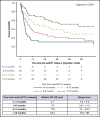Postrelapse survival in diffuse large B-cell lymphoma after therapy failure following autologous transplantation
- PMID: 31167818
- PMCID: PMC6560348
- DOI: 10.1182/bloodadvances.2019000102
Postrelapse survival in diffuse large B-cell lymphoma after therapy failure following autologous transplantation
Abstract
Outcomes for diffuse large B-cell lymphoma (DLBCL) patients relapsing after autologous hematopoietic cell transplantation (auto-HCT) have been historically poor. We studied outcomes of such patients using data from 4 transplantation centers. Eligibility criteria included adult patients (age ≥18 years) with DLBCL experiencing disease relapse after auto-HCT performed during 2006 to 2015. The time period was stratified into 2 eras (era 1, 2006-2010; era 2, 2011-2015). The primary end point was postrelapse overall survival (PR-OS). Secondary end points were factors prognostic of PR-OS. Of the 700 patients with DLBCL who underwent auto-HCT, 248 (35%) relapsed after auto-HCT. Median PR-OS of all relapsed DLBCL patients after auto-HCT (n = 228) was 9.8 months (95% confidence interval [CI], 7-15). Median PR-OS was significantly better for patients in complete (17.8 months; 95% CI, 7.9-41.6) vs partial remission at auto-HCT (7.1 months; 95% CI, 5.4-11; P = .01), those undergoing auto-HCT >1 year (12.8 months; 95% CI, 7.6-24.9) vs ≤1 year after DLBCL diagnosis (6.3 months; 95% CI, 4.5-9.2; P = .01), and those with late (56.4 months; 95% CI, 23.7-∞) vs early relapse (5.9 months; 95% CI, 4.5-8.8; P < .0001). On multivariate analysis, although late relapse (hazard ratio [HR], 0.21; 95% CI, 0.13-0.34; P < .0001) was associated with significantly lower mortality, the risk of mortality increased with age (HR, 1.25 per decade; 95% CI, 1.06-1.48; P = .009). This is the largest study to date to evaluate outcomes of DLBCL patients relapsing after auto-HCT. Our study provides benchmarking for future trials of chimeric antigen receptor T cells and other promising agents evaluating PR-OS after auto-HCT.
© 2019 by The American Society of Hematology.
Conflict of interest statement
Conflict-of-interest disclosure: The authors declare no competing financial interests.
Figures






References
-
- National Cancer Institute : Surveillance, Epidemiology, and End Results: Cancer Stat Facts: NHL—Diffuse Large B-cell Lymphoma (DLBCL). https://seer.cancer.gov/statfacts/html/dlbcl.html. Accessed 1 February 2019.
-
- Siegel RL, Miller KD, Jemal A. Cancer statistics, 2019. CA Cancer J Clin. 2019;69(1):7-34. - PubMed
-
- Coiffier B, Lepage E, Briere J, et al. . CHOP chemotherapy plus rituximab compared with CHOP alone in elderly patients with diffuse large-B-cell lymphoma. N Engl J Med. 2002;346(4):235-242. - PubMed
-
- Pfreundschuh M, Trümper L, Osterborg A, et al. ; MabThera International Trial Group . CHOP-like chemotherapy plus rituximab versus CHOP-like chemotherapy alone in young patients with good-prognosis diffuse large-B-cell lymphoma: a randomised controlled trial by the MabThera International Trial (MInT) Group. Lancet Oncol. 2006;7(5):379-391. - PubMed
-
- Philip T, Guglielmi C, Hagenbeek A, et al. . Autologous bone marrow transplantation as compared with salvage chemotherapy in relapses of chemotherapy-sensitive non-Hodgkin’s lymphoma. N Engl J Med. 1995;333(23):1540-1545. - PubMed
Publication types
MeSH terms
LinkOut - more resources
Full Text Sources
Research Materials
Miscellaneous

